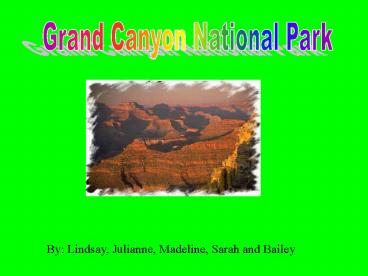Grand Canyon National Park - PowerPoint PPT Presentation
1 / 13
Title:
Grand Canyon National Park
Description:
Please be sure while visiting the Grand Canyon you follow ... Some species of endangered birds are the peregrine falcon, bald eagle, and willow flycatcher. ... – PowerPoint PPT presentation
Number of Views:1935
Avg rating:3.0/5.0
Title: Grand Canyon National Park
1
Grand Canyon National Park
By Lindsay, Julianne, Madeline, Sarah and Bailey
2
Principles of Leave No Trace
- Please be sure while visiting the Grand Canyon
you follow these rules and Leave No Trace. - Plan Ahead and Prepare
- Travel and Camp on Durable Surfaces
- Dispose of Waste Properly
- Leave What You Find
- Minimize Campfire Impacts
- Respect Wildlife
- Be considerate of Other Visitors
- Thank
You!
3
Wildlife
- At Grand Canyon 75 species of mammals, 50 species
of reptiles and amphibians, 25 species of fish,
and over 300 species of birds exist. - Ponderosa pine is the most common tree in the
forest.Pinyon pine and Utah juniper are also
common trees. Gambel oak is another tree in the
forest.The trees are interspersed with
drought-resistant shrubs like cliffrose,
fernbush, and serviceberry. Warm, sunny areas
along the rim may be home to desert plants like
banana yucca and claretcup cactus. - Much of the vegetation in the inner canyon is
typical of that found in deserts to the south
cacti and drought-resistant shrubs. Riparian
plants include thickets of willow and tamarisk.
4
More about Wildlife
Mule deer are common throughout the park and are
the mammals most commonly seen on the rim. Desert
bighorn inhabit the remote slopes of the inner
canyon but are occasionally seen on established
trails. Bobcats and coyotes range from rim to
river, and a small population of mountain lions
exists in the park. Among the smaller mammals
that inhabit Grand Canyon are ringtails (closely
related to raccoons), beavers, gophers,
chipmunks, several varieties of squirrels,
rabbits and bats. Reptiles and amphibians are
represented by a wide variety of lizards, snakes
(including the unique Grand Canyon "pink"
rattlesnake), turtles, frogs, toads and
salamanders. Hundreds of species of birds make
their home in the park, along with countless
insects and arachnids (spiders and
scorpions). Some threatened and endangered
species are the Colorado River fish These fish
include the Colorado squawfish, humpback chub,
and bonytail chub. Some species of endangered
birds are the peregrine falcon, bald eagle, and
willow flycatcher.
5
Activities
- Two day trip from the top of the canyon to the
bottom walking or mule ride. - Hiking
- Gazing at canyon view
- Backpacking
- Camping
- Rafting trips
- Horseback/mule trips
- Bicycling
- Scenic air tours
- Interpretive programs offered by the NPS rangers.
6
Landforms
- The Grand Canyon is a series of canyons and
rock formations naturally formed by the Colorado
River. The Colorado River runs straight through
the canyon. As a result, nearly two billion years
are exposed in the layers of the canyon.
7
Formation of the Canyon
- The course of the Colorado River contributed to
the formation of the canyon, as well as
continental drift, and variations in season and
climate. During colder months, water may seep
into cracks between the rocks. When this water
turns to ice, it expands, forcing the rocks
apart. Sometimes, rocks are pushed off the edge,
and, on occasion, one will create a rock fall
that may dramatically change the landscape in the
side of the canyon. Flash floods carry the rocks
down the river the Colorado takes it from there.
Though the Glen Canyon Dam slows the large amount
of erosion caused by the river, there is a lot of
water flowing quickly down a narrow gorge.
8
History of the Park
- Senator Benjamin Harrison introduced the first
bills to create Grand Canyon National Park in
1882 and 83, and the same in 86. All were
unsuccessful. 22 years later, in 1908, the Grand
Canyon National Monument was created. 2 years
before Arizona received statehood, two more
senate bills were introduced but failed to create
a National Park. In 1916, the NPS was created,
and in 1917, both House and Senate bills were
introduced, and both bills passed the next year.
President Woodrow Wilson signed the Grand Canyon
Bill in 1919.
9
Five Unique Things About the Grand Canyon
- The Grand Canyon has preserved more than 2,700
Indian campsites, where the Indians lived for at
least 4,000 years. - The Grand Canyon is one of the 7 natural wonders
of the world. - The South Rim has a climate that is very close
to the climate in the Arid Southwest. - The North Rim is 1,000 feet higher than the
South Rim, but the South Rim is cooler, and
wetter. Also it is very heavily forested. - The Inner Canyon is hot and dry. It can only be
reached by foot, mule, and boat.
10
No dams exist within Grand Canyon National Park,
By that standard, Grand Canyon is 277 miles/446
km long. It begins at Lees Ferry and ends at
Grand Wash CliffsWidth and depth of the canyon
vary from place to place. At the South Rim, near
Grand Canyon Village, it's a vertical mile (about
5000 feet/1524 m) from rim to river, or 7
miles/11.3 km by trail. At its deepest, it is
6000 vertical feet/1829 m from rim to river. The
width of the canyon at Grand Canyon Village is 10
miles/16 km (rim to rim), though in places it is
as much as 18 miles/29 km wide.
Size
11
Geographical Location
- 60 miles north of Williams, Arizona
- 80 miles northwest of Flagstaff
- Grand Canyon lies entirely within the state of
Arizona.
12
Sources
- www.nps.gov/
- www.doi.gov/
- www.fws.gov//
- www.nationalgeographics.com
- www.kaibab.org
13
Come Visit the
Grand Canyon National Park































